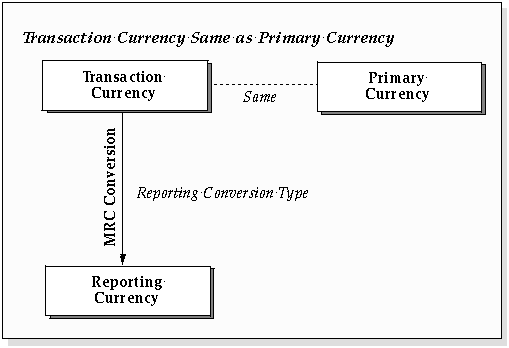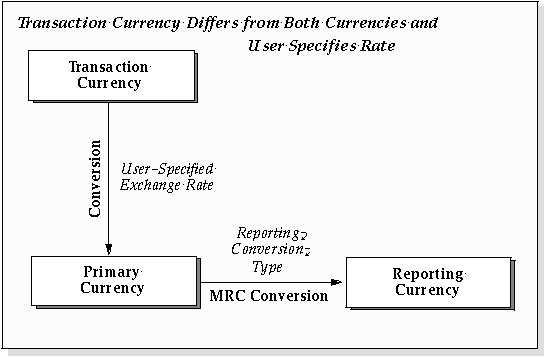| Previous | Next | Contents | Index | Glossary | Library |
Note: As of January 1, 1999, the national currencies of countries who are members of the European Monetary Union (EMU) will become another denomination of the Euro, the pan-European currency. Fixed exchange rates will be used between the Euro and each EMU currency.

When the transaction and primary currencies are the same, no conversion is needed to your primary currency. When MRC converts the transaction to your reporting currency, it uses the appropriate reporting conversion type you specified for the application and operating unit that originated the transaction.
| See: | Step 5 - Define Conversion Options for Each Application |
| Step 6 - Define General Ledger Conversion Rules |

Your application converts the transaction to your primary currency using a conversion rate type you specify, or the rate type EMU Fixed when both of your currencies are either an EMU currency or the Euro. For example, EMU to EMU, EMU to Euro, or Euro to EMU.
MRC converts the transaction to your reporting currency using the appropriate reporting conversion type you specified for the application and operating unit that originated the transaction.
Note: The only exception to the case above is when you specify your own transaction-to-primary currency conversion rate. This case is explained in the next diagram.
Example 1
You receive an invoice for 1,000.00 Australian dollars (AUD) from an Australian supplier. Your organization uses spot rates to account for the invoice in your primary set of books, which is maintained in Canadian dollars (CAD). You use corporate exchange rates to convert amounts to U.S. dollars (USD) for reporting purposes.
Summary of related information:
| Transaction currency: | AUD |
| Primary currency: | CAD |
| Reporting Currency: | USD |
| Spot exchange rate (AUD to CAD): | 0.9181 |
| Corporate exchange rate (AUD to USD): | 0.6409 |
This is how the invoice will be converted:
| Transaction amount: | 1,000.00 AUD |
| Primary amount: | 918.10 CAD (0.9181 * 1,000.00 AUD) |
| Reporting amount: | 640.90 USD (0.6409 * 1,000.00 AUD) |

Your application converts the transaction to your primary currency using the rate you specify. The conversion rate type will be User in both your primary and reporting set of books.
MRC converts the converted primary currency transaction to your reporting currency using the appropriate reporting conversion type you specified for the application and operating unit that originated the transaction.
Example 2
You receive an invoice for 1,000.00 Australian dollars (AUD) from an Australian supplier. Your contract with the supplier was originally negotiated using prices in Canadian dollars. The exchange rate used at the time of the agreement was 0.8950 (1 Australian dollar = 0.8950 Canadian dollars). This is also the rate specified on the invoice. Your organization uses corporate exchange rates to convert amounts to U.S. dollars for reporting purposes.
Summary of related information:
| Transaction currency: | AUD |
| Primary currency: | CAD |
| Reporting Currency: | USD |
| User-specified rate (AUD to CAD): | 0.8950 |
| Corporate exchange rate (CAD to USD): | 0.6974 |
This is how the invoice will be converted:
| Transaction amount: | 1,000.00 AUD |
| Primary amount: | 895.00 CAD (0.8950 * 1,000.00 AUD) |
| Reporting amount: | 624.17 USD (0.6974 * 895.00 CAD) |

When the transaction and reporting currencies are the same, no conversion is needed to your reporting currency. MRC uses the transaction amount as the reporting currency amount.
Your application converts the transaction to your primary currency using one of these conversion rate types:
User-specified: the conversion rate type you specified
EMU Fixed: when both of the currencies are either an EMU currency or the Euro
User: when you specify a transaction-to-primary currency conversion rate.
MRC converts transaction amounts in full compliance with European Commission guidelines that require using the fixed exchange rate between the Euro and each EMU currency.
Example
In February 1999, after the transition period to the Euro begins, you receive an invoice for 1,000 Belgian francs (BEF). Your primary set of books is still maintained in your national currency units (Belgian francs), and you are preparing to convert your operations and financial accounting to the Euro. For this reason, you have created a reporting set of books with a reporting functional currency of Euro and assigned it to your primary set of books.
Summary of related information:
| Transaction currency (EMU): | BEF |
| Primary currency (EMU): | BEF |
| Reporting Currency: | EUR |
| Fixed conversion factor (EUR to BEF): | 40.7048 |
This is how the invoice will be converted:
| Transaction amount: | 1,000 BEF |
| Reporting amount: | 24.57 EUR (1000 BEF / 40.7048) |
Assign Reporting Sets of Books
Defining Conversion Rate Types
Overview of Multi-Currency Accounting
| Previous | Next | Contents | Index | Glossary | Library |